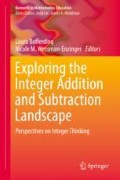Abstract
These four chapters describe studies of using models for integer addition and subtraction. The models draw principally on the two grounding metaphors of object collection and motion along a path. A strength of all chapters is detailed analysis of how the models are and can be implemented and how they influence student’s learning. Together the chapters demonstrate that teaching with any model requires care and attention to achieve conceptual clarity. Teachers need to act entirely within in the world of the model, only later adding other models to round out the mathematical picture. The teaching of integers is a key point for maintaining students' confidence that mathematics is a subject that makes sense. These chapters demonstrate how use of models can assist in this goal.
Access this chapter
Tax calculation will be finalised at checkout
Purchases are for personal use only
References
Groves, S., & Stacey, K. (1998). Calculators in primary mathematics: Exploring number before teaching algorithms. In L. Morrow & M. Kenney (Eds.), The teaching and learning of algorithms in school mathematics (pp. 121–129). Reston, VA: The National Council of Teachers of Mathematics.
Hayes, R. L. (1998). Teaching negative number operations: A comparative study of the neutralisation model using integer tiles. Unpublished doctoral dissertation, University of Melbourne, Melbourne, Australia.
Lakoff, G., & Johnson, M. (1980). Metaphors we live by. Chicago, IL: The University of Chicago Press.
Lakoff, G., & Núñez, R. (2000). Where mathematics comes from. New York, NY: Basic Books.
Marthe, P. (1979). Additive problems and directed numbers. In D. Tall (Ed.), Proceedings of the 3rd Conference of the International Group for the Psychology of Mathematics Education (pp. 317–323). Coventry, UK: PME.
Widjaja, W., Stacey, K., & Steinle, V. (2011). Locating negative decimals on the number line: Insights into the thinking of pre-service primary teachers. Journal of Mathematical Behavior, 30(1), 80–91. https://doi.org/10.1016/j.jmathb.2010.11.004
Author information
Authors and Affiliations
Corresponding author
Editor information
Editors and Affiliations
Rights and permissions
Copyright information
© 2018 Springer International Publishing AG, part of Springer Nature
About this chapter
Cite this chapter
Stacey, K. (2018). Commentary on Chapters 4 to 7: Students’ Learning of Integer Addition and Subtraction Using Models. In: Bofferding, L., Wessman-Enzinger, N. (eds) Exploring the Integer Addition and Subtraction Landscape. Research in Mathematics Education. Springer, Cham. https://doi.org/10.1007/978-3-319-90692-8_12
Download citation
DOI: https://doi.org/10.1007/978-3-319-90692-8_12
Published:
Publisher Name: Springer, Cham
Print ISBN: 978-3-319-90691-1
Online ISBN: 978-3-319-90692-8
eBook Packages: EducationEducation (R0)

